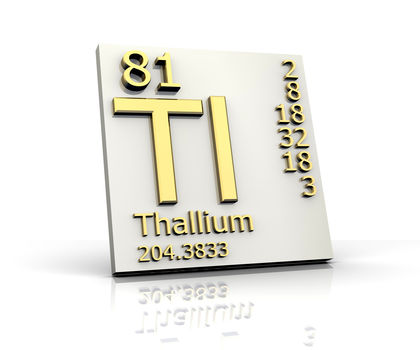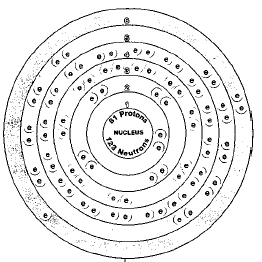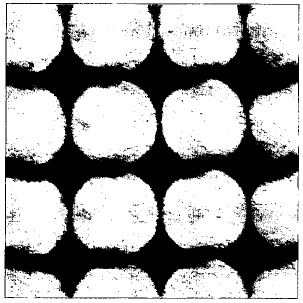THALLIUM


Overview
Thallium is a member of the aluminum family, Group 13 (IIIA) on the periodic table. The periodic table is a chart that shows how chemical elements are related to one another. Thallium is also a member of the heavy metals, along with gold, platinum, and lead.
Thallium was first discovered by means of a spectroscope. A spectroscope is a device for analyzing the light produced when an element is heated. The spectrum (plural: spectra) of an element consists of a series of colored lines that are different for every element. The brightest lines in the spectrum of thallium are green, which accounts for its name. In Greek, the word thallos means "green twig." The green lines in thallium's spectrum look like green twigs.
SYMBOL
Tl
ATOMIC NUMBER
81
ATOMIC MASS
204.37
FAMILY
Group 13 (IIIA)
Aluminum
PRONUNCIATION
THA-lee-um
Thallium is a rather uncommon element. Still, some of its compounds have important applications. For example, thallium sulfate (Tl 2 SO 4 ) has long been used as a rodenticide (rat and mouse poison). One form of thallium is sometimes used to study the flow of blood in the body. It shows how well the heart is working.
Discovery and naming
The spectroscope was invented in 1814 by German physicist Joseph von Fraunhofer (1787-1826). Forty years later, German chemists Robert Bunsen (1811-99) and Gustav Robert Kirchhoff (1824-87) improved on the instrument and showed how it could be used to study chemical elements. (See sidebar on Bunsen in the cesium entry in Volume 1.)
Scientists were fascinated by the instrument. They could detect the presence of elements without actually seeing them. A mineral is made of many elements, each of which gives off its own series of colored (spectral) lines. The spectroscope is able to detect all the elements present in the mineral.
Within a period of four years after the work of Bunsen and Kirchhoff, four new elements were discovered: cesium, rubidium , thallium, and indium . All four elements are named after the color of their spectral lines. The discoverer of thallium was British physicist Sir William Crookes (1832-1919).
Interestingly, thallium was discovered at almost the same time by French chemist Claude-Auguste Lamy (1820-78). Lamy discovered thallium the "old fashioned way," by separating one of its minerals in the laboratory. For a short time, there was a difference of opinion as to whether Lamy or Crookes was the "real" discoverer of thallium. Eventually, the decision was made in favor of Crookes.
Physical properties
Thallium is a heavy, bluish-white metal that resembles lead, element 82. Thallium is very soft and melts easily. It is soft enough to cut with an ordinary knife and will leave a mark on paper if rubbed across it.
Thallium has a melting point of 302°C (576°F) and a boiling point of 1,457°C (2,655°F). Its density is 11.85 grams per cubic centimeter.
Chemical properties
Thallium is a fairly active element. It reacts with acids and with oxygen in the air. When exposed to air, it forms a thin coating of thallium oxide (Tl 2 O) that peels off easily. As the coating drops off, a new layer forms in its place.
Occurrence in nature
Thallium is quite uncommon in the Earth's crust. Its abundance is estimated to be about 0.7 parts per million. That puts it in the bottom half among the elements in terms of abundance. It is about as common as iodine or tungsten.
The most common minerals containing thallium are crookesite, lorandite, and hutchinsonite.
Isotopes
Two naturally occurring isotopes of thallium exist, thallium-203 and thallium-205. Isotopes are two or more forms of an element. Isotopes differ from each other according to their mass number. The number written to the right of the element's name is the mass number. The mass number represents the number of protons plus neutrons in the nucleus of an atom of the element. The number of protons determines the element, but the number of neutrons in the atom of any one element can vary. Each variation is an isotope.
Two dozen radioactive isotopes of thallium have also been made. A radioactive isotope is one that breaks apart and gives off some form of radiation. Radioactive isotopes are produced when very small particles are fired at atoms. These particles stick in the atoms and make them radioactive.
Thallium-201 is used by doctors to determine how well a person's heart is working. In many cases, the isotope is used as a stress test. Thallium-201 is injected into the patient's blood-stream as he or she exercises on a treadmill or bicycle. As soon as the exercise ends, the patient lies down. A large camera is passed over the body. The camera records the radiation given off by the isotope. This record shows whether the patient's heart is working properly or not.
Extraction
Thallium is obtained as a by-product of the recovery of lead and zinc. Gases from the recovery process are captured. They are then treated to obtain the pure metal.
Uses and compounds
For many years, thallium sulfate (Tl 2 SO 4 ) was used as a rodenticide. It worked well with rats and mice because it passes through their skin easily. Once inside their bodies, it causes

Unfortunately, thallium sulfate has the same effects on humans. Accidental poisoning, especially of young children, led to the banning of thallium sulfate as a rodenticide in the United States in 1975. Today, safer compounds (for humans, not rats) are available for rodenticides.
Thallium is too expensive to have many practical applications. There are a few exceptions, however, that make use of special properties of the elements and its compounds. For example, thallium sulfide (Tl 2 S) is sometimes used in photocells. Photocells are devices that convert light into electrical energy. In some kinds of light, thallium sulfide does not conduct electricity very well. But in other kinds of light, it conducts very well. Special photocells can be built to take advantage of this property.
An alloy of thallium and mercury can be used to make low-temperature thermometers. An alloy is made by melting and mixing two or more metals. The mixture has properties different from those of the individual metals. The thallium-mercury alloy remains liquid at -60°C (-76°F). At that temperature, a mercury-only thermometer would freeze solid.
An interesting new application of thallium is in superconducting materials. Superconductors have no resistance to the flow of electricity. Once an electrical current begins flowing in the material, it continues to flow forever. Superconducting materials may have some very important practical applications in the future.
Accidental poisoning, especially of young children, led to the banning of thallium sulfate as a rodenticide in the United States in 1975.
Health effects
Both thallium and its compounds are very toxic. A person exposed to the element or its compounds over long periods of time develops weakness, pain in the arms and legs, and loss of hair. A high dosage in a short time leads to different symptoms. These symptoms include nausea, vomiting, diarrhea, pain in the arms and legs, coma, convulsions, and even death. People who work with thallium use extreme caution to avoid coming into contact with the material.
are there any other elements with similar properties with thallium
thanks